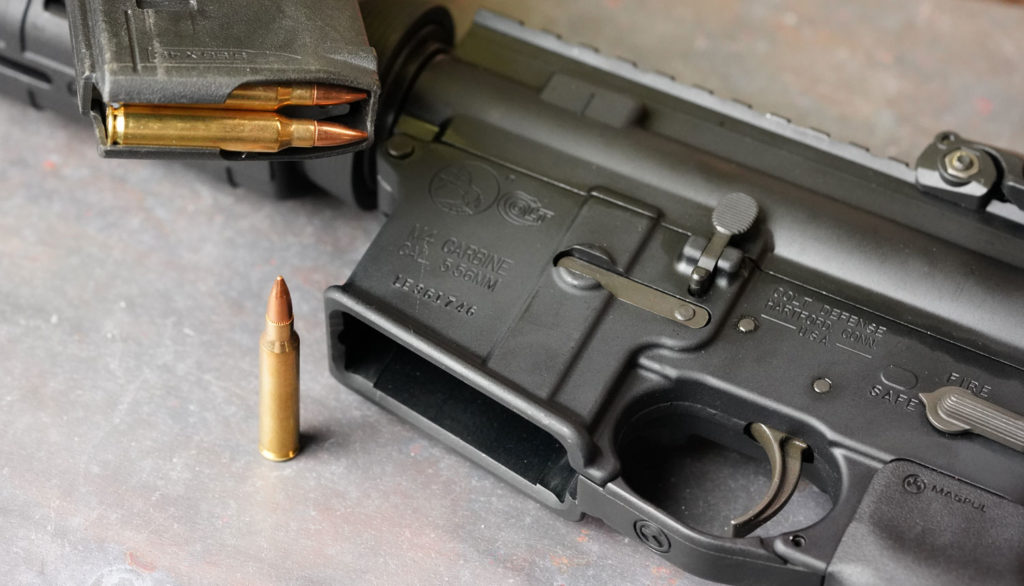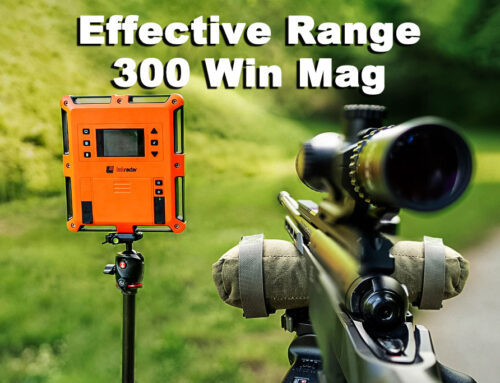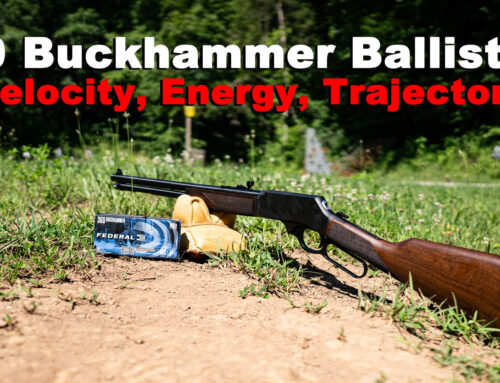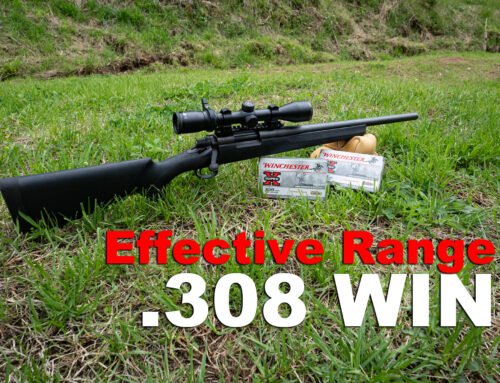If you’re reading this, odds are good you know 5.56 is a rimless, bottlenecked cartridge developed by FN Herstal. But, you might not be as familiar with some of the military’s intricacies inside the caliber itself. I’m talking about M193 vs M855.
Militaries standardized the cartridge for NATO forces in 1980. Before that, NATO adopted the 7.62×51 in 1954.
The 5.56 is derived from the 223 Rem. The two cartridges share identical dimensions. They are not, however, interchangeable.
The power load of the 5.56 is substantially greater than that of the 223 Rem. So, 223 Rem may be fired in a weapon rated for 5.56, but never vice versa.
Types of 5.56×45 Ammunition

The military uses several types of 5.56 cartridges. These include the M196 and M856, which are both tracer rounds with distinctive orange tips, the M199 dummy round, the M200 blank. The military also fires M862 but they use it exclusively during training exercises.
The civilian market most commonly has access to one of two types of 5.56: M193 Ball and M855 Ball. A ton of this ammo is manufactured at the Lake City Army Ammunition Plant in Missouri.
M193 vs M855 Ammo
What is M193?

If you were to label any of the 5.56 cartridges “vanilla,” you would pick the M193. It is the standard cartridge the military issues for field use in the M16A1 rifle. It features a 55 grain bullet. A lead core with a full metal jacket make up this cartridge. Its muzzle velocity is 3,250 feet per second, although that speed quickly tapers off. You might also be interested to know the M193 performs poorly when asked to penetrate any kind of barrier. Because the M193’s jacketed bullet is not designed to expand during penetration, it is permissible for use in international warfare according to the rules laid out during The Hague Convention of 1899. (Please note that it is inadvisable for a civilian to conduct international warfare.)
Buy Federal XM193 Ammo here from AmmoForSale.com.
What is M855?
These are the “Green Tips” You’re Looking For
 The M855 (also known as an SS109 or “penetrator”) features a heavier 62 grain full metal jacketed projectile, with a seven grain steel tip which is painted green for easy identification and a spitzer boat tail. The M855 is slower than the M193 at 3,025 feet per second, although its greater sectional density and drag coefficient make it more accurate over long distances. The M855’s steel tip strengthens it considerably: Under optimal circumstances it will penetrate 15 to 20 inches into soft tissue, and also pierce 0.12 inches of steel at approximately 2,000 feet.
The M855 (also known as an SS109 or “penetrator”) features a heavier 62 grain full metal jacketed projectile, with a seven grain steel tip which is painted green for easy identification and a spitzer boat tail. The M855 is slower than the M193 at 3,025 feet per second, although its greater sectional density and drag coefficient make it more accurate over long distances. The M855’s steel tip strengthens it considerably: Under optimal circumstances it will penetrate 15 to 20 inches into soft tissue, and also pierce 0.12 inches of steel at approximately 2,000 feet.
The M193 will reliably fragment during penetration at a velocity around 2,700 fps or faster.
The tougher M855 is less inclined to fragment than the M193. For that reason the world considers it a more humane combat cartridge. However, the M855 is capable of yawing during higher velocity penetration, during which it may fragment at the cannelure. (Yawing is when the bullet’s rotation starts to stray away from the path of flight. You’ll hear shooters refer to this sideways turn as “tumbling” quite frequently.)
Fragmentation transfers greater energy within the target than if the bullet had merely passed through, a consideration if you would implement either M193 or M855 for self-defense.
The M855 has by no means a magical bullet that is capable of boring through any barrier. Our troops in Iraq frequently found the M855 insufficient to penetrate auto glass, even at close range, and the bullet’s ability to puncture steel drops markedly at the 1,000 foot mark. At approximately 1,650 feet the M855 ceases to be practical for engaging a specific target.
Buy Federal 5.56×45 M855 ammo here at AmmoForSale.com.
Totally Mil-Spec, Right?

Note: while a cartridge may be accurately designated as M193 or M855, almost all commercially available 5.56 ammunition is not technically mil-spec.
Federal indicates this by adding an “X” prefix before a round’s designation. Other manufacturers may omit the distinction entirely. The difference between a 5.56 round that is mil-spec and one that isn’t is generally so minute that it is moot. Manufacturers produce the ammo to such tight tolerances civilian shooters likely won’t notice any difference.
When To Use M193 or M855
Also note that the relatively long M855 projectile will work well in a 1:7 twist barrel, but will likely incur performance problems in 1:9 twist or 1:12 twist barrels. The M193 is less sensitive to barrel twist, but may present issues when fired from a barrel with a slower twist.
We are very fortunate to have access to so many manufacturers’ offerings in both M193 and M855. The only true way of discerning which side you’re on in the M193 vs M855 debate is through healthy experimentation. So, get ready for some range time.
We can say though – if penetration is your priority you would most certainly be happier with a magazine full of M855 cartridges.





Very comprehensive; thanks!
Thanks again Daniel!
Interesting and very informative. I have an AR-15 witch I dearly love and my favorite.
Nuff said…. Thank you for all the details
Thanks Chad – glad to hear it was helpful.
When is someone going to publish information that there is a difference of dimensions between the cartridge case of the M193 and the M855. The M system designator does not determine the cartridge case but the type of bullet,weight, overall length of complete cartridge as completed, and bullet diameter. It does not identify that the 855 case has a slightly different radius of the shoulder and that the neck is longer, which means that a high pressure could exist if a M855 cartridge is fired in a M193 or .223 chamber.
Hi Steve, you’re right about the casing being slightly different between the 5.56×45 and .223 Remington. Since this article is about the M193 vs. M855 bullets, we focused only on the differences in these two projectiles.
We do touch on that pressure difference in our 223 Wylde article. If you are curious, you can find it here:
https://www.ammoforsale.com/ammo-club/223-wylde/.
Thanks for the tip. It is hard to get complete information. I am curious too know if the “civilian” M193 will still fragment. That is its primary advantage for self defense.
Awesome review. Put into the most simplest terms for anyone to understand.
Thank you Tom!
I’m curious if there is a difference in trajectory and arc between the rounds. I found that with M855, I would have to aim slightly lower to account for bullet rise. Does the increased velocity of the M193 decrease the rise in bullet height for distant targets?
Good question Ryan – based on what you’re seeing, I would guess that you’re shooting at a target about 100 yards away. Is that accurate?
Here’s why I’d guess that. M855 and M193 rounds are pretty similar ballistically but if you’re zeroed at 200 yards, the M855 does arc slightly higher at 100 yards.
Trajectory at Muzzle/100 Yds/200 Yds/300 Yds
M193 -2.4 / 1.1 / 0 / -7.3
M855 -1.5 / 1.6 / 0 / -7.7
When the M855(A559) came out. Armorers found to lower the rear sight all the way down and raise up two (2) clicks. Loosen the screw on the elevation dial and lower the dial all the way down. Tighten the screw. Ready to shoot.
SS109 was used in Somalia, it sucked. The steel core definitely penetrates, the problem being is it goes in intact and leaves intact in a perfect straight line leaving behind small .223 sized holes. Would take 5 to 6 shots to stop a skinny. The older 55gr 193 would sometimes tumble upon impact hence the “less humane” but more effective nature. I never buy SS109 62gr. As soon as I see 62gr listed I move on.
So what about OTM rounds? 55, 75, 69, 77? How do they fair over the FMJ for terminal effect?
Great question Daniel. We found this work published by TheFirearmBlog pretty informative. Basically, they found OTM bullets performed more comparably to FMJ than to what most of us would look for in a hunting or expanding defense round. (https://www.thefirearmblog.com/blog/2015/04/23/why-otm-%e2%89%a0-jhp/)
Just wanted to say, great article. Found myself not really knowing the difference and your article was informative and well written. Thank you.
The .223 round was developed from the .222 Special the .224 the redesigned the.223 for Eugene Stoner for the AR15 and the US Army. It was later designated the 5.56 mm M193 Ball round. The M16 is just the military designation for the AR15. I was issued a stamped Colt AR15 M16A1 rifle in the Army back in 1980. It’s the M855 NATO that is different.